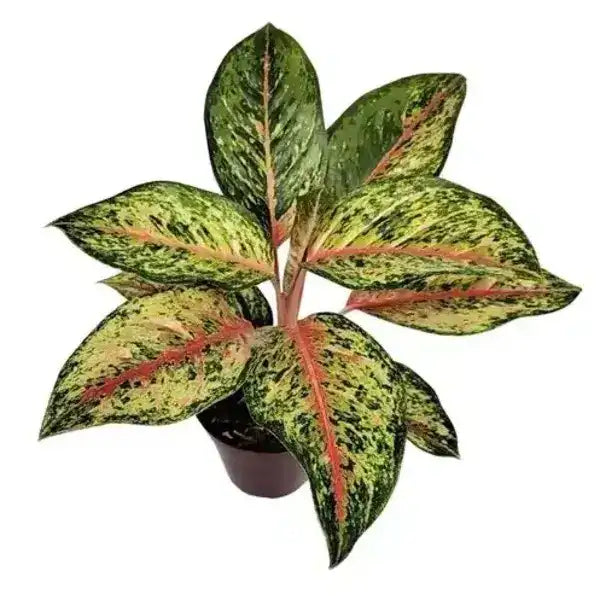
Aglaonema 10 Karat Plant
Size: Single Plant | 2.5″ Pot Included | Secure Packing
The Aglaonema 10 Karat Plant, like other Aglaonema (Chinese Evergreen) varieties, is a popular and relatively easy-to-care-for houseplant known for its vibrant foliage.
Here's a comprehensive guide to Aglaonema 10 Karat Plants care:
1. Light:
Bright, indirect light is ideal. This helps maintain the vibrant coloration of its leaves.
It can tolerate lower light conditions, but growth may slow and the colors might fade.
Avoid direct sunlight, especially harsh afternoon sun, as it can scorch the leaves and cause them to fade or burn. If placed near a window, use sheer curtains to filter the light.
2. Watering:
Allow the top 1-2 inches (2.5-5 cm) of soil to dry out before watering again. Aglaonema prefers consistently moist soil but absolutely hates being waterlogged, which can lead to root rot.
Water slowly and thoroughly until water drains from the bottom of the pot. Discard any excess water in the saucer.
Reduce watering frequency in winter when the plant's growth naturally slows down.
Signs of overwatering: Yellowing leaves, wilting, mushy stems, or a foul odor from the soil.
Signs of underwatering: Drooping leaves, crispy brown edges, or very dry, compacted soil.
3. Humidity:
Aglaonemas are tropical plants and appreciate higher humidity levels (around 60-70%), but they can tolerate average indoor humidity.
To increase humidity, you can:
Mist the leaves occasionally.
Use a pebble tray filled with water near the plant (ensure the pot isn't sitting in the water).
Place a humidifier nearby.
Group plants together to create a more humid microclimate.
4. Temperature:
Maintain consistent room temperatures between 65°F to 80°F (18°C to 27°C).
Avoid exposing them to drafts, sudden temperature changes, or temperatures below 60°F (15°C), as this can cause cold damage and stress the plant. Keep them away from air conditioning or heating vents.
5. Soil:
Use a well-draining potting mix that retains some moisture.
A mix of peat moss, perlite, and vermiculite or pine bark generally works well.
A slightly acidic pH level between 5.5 and 6.5 is preferred.
6. Fertilization:
Feed your Aglaonema with a balanced liquid fertilizer during the growing season (spring and summer), typically once a month or every 4-6 weeks.
Dilute the fertilizer to half strength to avoid over-fertilizing, which can burn the roots.
Reduce or stop fertilizing during the fall and winter months when growth slows down.
7. Pruning:
Regularly remove any yellow, damaged, or dead leaves by trimming them back to the base of the plant using clean, sharp scissors or pruners. This helps the plant redirect energy to healthy growth and keeps it looking tidy.
You can also trim leggy stems to encourage bushier growth.
8. Repotting:
Aglaonemas are relatively slow growers, so they don't require frequent repotting.
Repot every 2-3 years, or when you notice the plant becoming root-bound (roots circling the pot or growing out of the drainage holes).
Choose a pot that is only 1-2 inches wider than the current pot.
9. Propagation:
The easiest methods for propagating Aglaonema are stem cuttings (in water or soil) or root division.
Stem Cuttings:
Take a healthy stem cutting about 4-6 inches long, ensuring it has at least one node.
You can place the cutting in a jar of water (changing the water regularly) or directly plant it in moist, well-draining potting soil.
For soil propagation, dipping the cut end in rooting hormone can be beneficial.
Provide bright, indirect light and maintain warmth and humidity. New growth indicates successful rooting.
Root Division: This involves carefully separating the plant into smaller sections, each with its own roots and foliage, during repotting.
10. Common Problems and Solutions:
Yellowing leaves: Often a sign of overwatering, but can also indicate underwatering or aging. Check soil moisture and adjust watering.
Brown leaf tips/edges: Usually caused by low humidity, too much fertilizer, or fluoride/chlorine in tap water. Increase humidity, adjust fertilizer, or use distilled/rainwater.
Drooping leaves: Can indicate underwatering or too much direct sunlight. Check soil moisture and light conditions.
Leaf spot disease: Appears as dark, irregular spots. Remove affected leaves, improve air circulation, and avoid overhead watering.
Pests: Aglaonemas are generally resistant, but occasionally susceptible to spider mites, mealybugs, and scale insects. Inspect regularly and treat promptly with appropriate measures (e.g., insecticidal soap).
By following these care tips, your Aglaonema 10 Karat Plant should thrive and bring beautiful color to your indoor space!
Frequently Bought Together
Hand picked brands
from California
We refined our collections, hand picking our brands, buying deep in the styles we love, slowly evolving into a perfectly balanced store offering the ideal fit for every woman.

